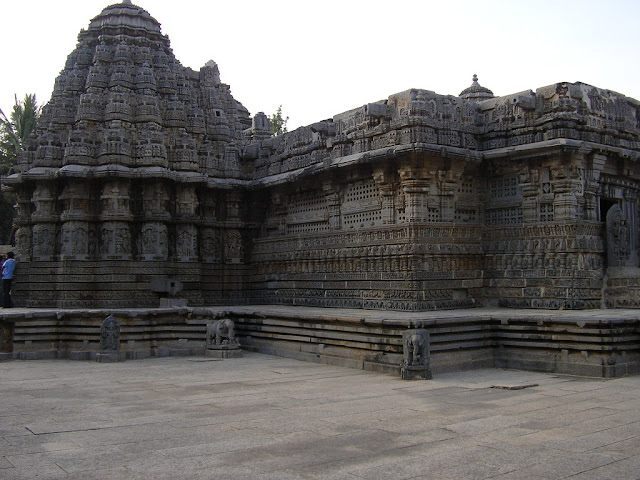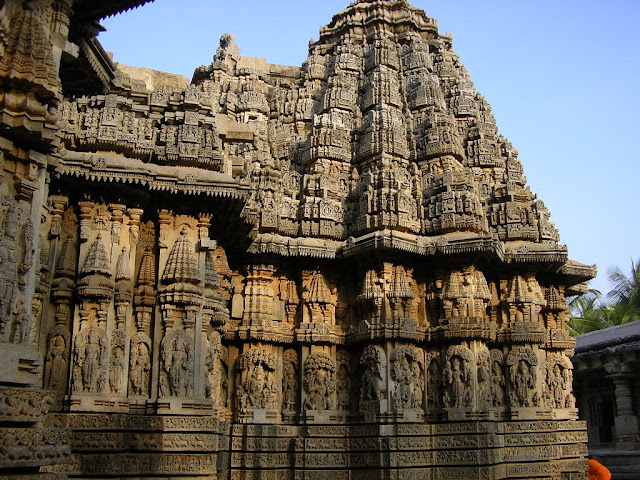Somnathpur is situated around 35 kms from Mysore city , 7 km from Snathemala on the road that leads to Talakadu. I had visited this place in Nov 2011. I had only half an hour back then and had captured some of the highlights of the magnificent architecture on my digital camera. There was so much more left to explore and i was waiting for an oppurtunity to get back there. The blog of my last visit is here:
srirangapatna-trail.
Hence i rode to Mysore on my 150 cc unicorn dazzler . I hired a guide who charged Rs.150 . He showed me some carvings that i had missed the last time . My thanks to him.
Somnathpur was established by Dandanayaka Somnath who was a general of the king Narasimha the Third, a Hoysala ruler. The temple is a Vishnu temple dedicated to god Chennakeshava , a form of lord Vishnu. . The temple took 68 years to be completed and involved a lot of hard work by scores of top architects of the era, Mallitamma, Masanatamma to name a few. It is said to be an exact replica of the Chennakeshava temples at Belur . The architects have used soap stone to accomodate intricate carvings. One look at the temple and you will know what i am talking about. The temple's grandeur cannot be described by mere words alone, hence these pics.
This stone slab , at the entrance, describes about the construction of the temple, the various grants made to it. Anyone interested to decipher it can look it up in the book Epigraphica Carnatica vol 5 page 924. The translation is 5 pages long! Do look it up.
The central 3 idols depict gods Venugopala, Chennakeshava and Janardhana . We also see Garuda at the extreme left and a cow on the extreme right.
Observe the straight lines of the carvings. Without the aid of any machines in that era, the architects have displayed perfection in skill. How steady thy hands!
The temple is star shaped. The guide had an explanation for this design. Since the sun and the moon have eclipses and since the stars do not, the temple is said to have been designed in this way so that its glory may never be eclipsed for all time to come. The guide was quick to point out that the sun is now known to be a star (not back then, perhaps)
The temple foundation is in 4 layers,
The base has elephant engravings suggesting strength
Above it, are the horsemen
Third layer consists of flowers suggesting beauty
The fourth layer has warriors and musicians.
Observe the fire god AGNI in the left of the top row.
The ten avatars of Vishnu are engraved to the finest detail. Among
others are Indra, Brahma, Saraswathi, Kama , Rati , Hanuman, Garuda and
many others(194 in all). The architects have engraved their names under
many sculptures. Mallithamma has carved the maximum of these. The effort
of the architects is sheer mind boggling. I feel this is the perfect
worship of the gods by these architects. After 900 years, they still
enthrall people and hopefully, for many generations more.
 |
| Lord Vishnu in a unique sitting posture over the snake Adishesha |
 |
| VENUGOPALA |
 |
| NATYA GANAPATHI |
 |
| MUSICIAN |
 |
| NATYA SARASWATHI |
 |
| NATYA SARASWATHI |
note the book (talegari) in her upper left hand
 |
| NATYA SARASWATHI (note the musicians below her) |
 |
| LAKSHMI |
 |
| BRAMHA |
|
whats with the pig head on his staff? anyone know the story?
Note the broken noses, amputated limbs of the statues. Most of the credit for this vandalism goes to General Malik Khafur and other muslim raiders who ravaged these temples during the 13th century. Noses were broken as an insult to idol worship and to render them useless for worship since Hindus do not worship broken idols.
 |
| DHANVANTARI (god of medicine) |
note the medicines in his hands
 |
| MATSYAAVATAARA (FISH) |
 |
| KOORMAAVATAARA (Turtle) |
 |
| LAKSHMI NARASIMHA |
Note young Prahallaada with folded hands on the right of Narasimha
 |
| GARUDA CARRYING LORD VISHNU AND HIS WIFE |
 |
| INDRA ON AIRAAVATHA |
Note the Vajraayudha weapon in his right hand. Vajraayudha is said to be forged from the backbone of a demon
 |
| LORD VISHNU |
Note the manner in which the hands hold the weapons, denoting the ease and the strength of the god
 |
| LAKSHMI NARAYANA |
As godess Lakshmi sits on Narayana's lap and rests her foot on the flower below, the flower sags to the wieght and an elephant rushes to support the flower with its trunk!
 |
| LORD VISHNU RESTING ON HIS MACE |
 |
| MAHISHAASURAMARDINI |
Note the unique posture as she grabs the demon with her left hand deseating him from the buffalo. note the lion in the background. The architect MALLITAMMA has carved his name below the statue.
 |
| MALLITAMMA |
 |
| RATI MANMATHA (gods of love) |
|
Manmatha is identified by his bow made of sugarcane. Note the leaves at the top of the bow.
These windows , called as Jaalandaras, are unique in pattern in that they are octagonal from outside and square from inside the temple.Note the unique statues below the windows.
Coming to the interior of the temple,
Note the different designs of the pillars and the square windows
The ceiling is intricately carved showing different stages of budding of a flower
note the painted colours
Note the small statues of people all around the circumference and the horse rider
The temple is TRIKOOTA in design i.e it has 3 inner sanctums housing Venugopala on the left, Janaardhana on the right and Keshava in the centre. The central original Keshava idol is missing, its whereabouts unknown. ASI has put another Keshava idol in its place.
 |
| VENUGOPALA |
 |
| JANAARDHANA |
|
Note the uniqueness of this statue. If you observe the trunk, the nipples appear like the eyes of a cow and the navel like the mouth of the cow.
 |
| KESHAVA |
This is not the original idol.
More vishnu idols with a lot of variations
 |
| LORD VISHNU RESTING ON HIS SHIELD |
Note the design of the shield
Note the unique design of the bow. It has some ring contraptions. More pictures on this bow design will follow. Has anyone found a similar design in any other temples elsewhere? please let me know.
 |
| VISHNU WITH A SHIELD IN THE LEFT HAND |
 |
| MOHINI |
 |
| VISHNU IN PADMASANA POSE |
To highlight the intricate carvings,
Mythology at its best
VAAMANA and TRIVIKRAMA
?BUDDHA ATTAINING GYNANA
Note the different animals in the carving. Buddha is considered to be an incarnation of Vishnu. No offence to religious radicals.
Note the shields. They are biconcave in shape. Traditionally, round shields have been used in India. These look quite Spartan in design. Can anyone shed any light on this subject?
Hiranyakashipu and Narasimha
Tales of Ramayana
 |
| SEETA SWAYAMVARA |
Note Ravana with ten heads on the right, failing to string the bow. Rama strings the bow. Seeta is seen on the left with a garland in her hands. Note the design of the bow.
Rama and Lakshmana fighting demons.
Rama, Seeta and Lakshmana being exiled to the forest. Dasharatha is seen on the right
Lakshmana cuts off Shurpanakhi's nose, Rama battles demons
Rama hunts the Mayamruga (deer) on seeta's request
Ravana disguised as a hermit abducting Seeta, Raavana fighting Jataaayu, the eagle.
Count the ten heads of Raavana . Note Hanuman and Sugriva, the monkey king.
Tales of MAHABHARATHA
 |
| BIRTH OF KRISHNA |
Note Vishnu with Lakshmi on the right. Vishnu is born as Krishna. Note the half open door. Vasudeva is helped by Adishesha (snake) as he takes the newborn to Gokula for safekeeping.
Krishna's childhood at Gokula
PUTANA tries to poison Krishna. Krishna sucks the life out of her. Putana is shown as a shrivelled body . Bones are visible.
Krishna stealing curds, killing a demon
A depiction of the forest where krishna grew up. The trees, cows, a monkey, an elephant, a river with fish, crocodiles and turtles are carved to perfection.
Krishna lifting Govardhana mountain with his left hand. People of Gokula taking shelter under the mountain , from Indra's wrath of torrential rain.
Krishna slaying Kalinga snake
Krishna slaying a demon in disguise of a horse
This one depicts Bhima as a child. The Kauravas hide in a tree. Bhima shakes the tree with his bare hands. The young Kauravas are seen falling to the ground ,head downwards!
Bhima goes to the demon BAKASURA with a cartload of food , fights and kills him.
The mythological creature called MAKARA, an amalgam of seven different animals. Symbol of the Hoysalas.
This temple is open from 8 30 am to 5 30 pm all days of the week. Refreshments are available at a nearby shop. If you decide to visit this place during summer, do wear socks. The stones will be burning hot. Since we have to remove our footwear outside the temple, the stones will make you dance if you enter barefoot. Thats exactly what happened to me! The guide wore socks and was calmly explaining the architecture while i was prancing around!
Since the idols are broken, the temple is no longer used for worship. Which is sad , seeing the devotion of the architects displayed in their work. This temple has made me to want to visit Belur and Halebidu. Looking forward to it after summer.































































































